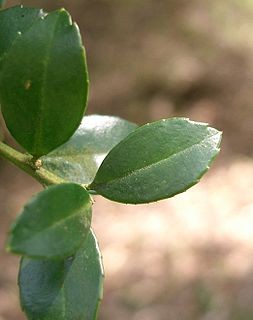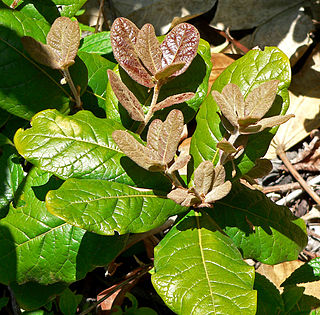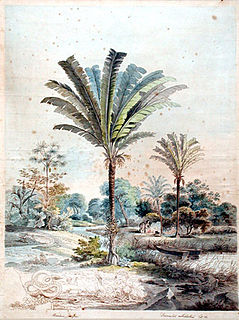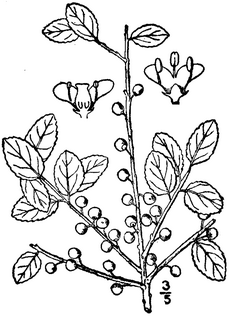
Quercus ilex, the evergreen oak, holly oak or holm oak, is a large evergreen oak native to the Mediterranean region. It takes its name from holm, an ancient name for holly. It is a member of the Cerris section of the genus, with acorns that mature in a single summer.

Syngonium is a genus of flowering plants in the family Araceae, native to tropical rain forests in southern Mexico, the West Indies, Central and South America. They are woody vines growing to heights of 10–20 m or more in trees. They have leaves that change shape according to the plant's stage of growth, and adult leaf forms are often much more lobed than the juvenile forms usually seen on small house plants. The scientific name of the genus comes from the Greek words σύν and γονή and refers to the fused ovaries of female flowers.

Heliconia, derived from the Greek word Ἑλικώνιος, is a genus of flowering plants in the family Heliconiaceae. Most of the ca 194 known species are native to the tropical Americas, but a few are indigenous to certain islands of the western Pacific and Maluku. Many species of Heliconia are found in the tropical forests of these regions. Several species are widely cultivated as ornamentals, and a few are naturalized in Florida, Gambia and Thailand. Common names for the genus include lobster-claws, toucan peak, wild plantains or false bird-of-paradise. The last term refers to their close similarity to the bird-of-paradise flowers (Strelitzia). Collectively, these plants are also simply referred to as heliconias.

Ilex opaca, the American holly, is a species of holly, native to the eastern and south-central United States, from coastal Massachusetts south to central Florida, and west to southeastern Missouri and eastern Texas.

Ilex cassine is a holly native to the southeastern coast of North America, in the United States from Virginia to southeast Texas, in Mexico in Veracruz, and in the Caribbean on the Bahamas, Cuba, and Puerto Rico. It is commonly known as dahoon holly or cassena, the latter derived from the Timucua name for I. vomitoria.

Ilex verticillata, the winterberry, is a species of holly native to eastern North America in the United States and southeast Canada, from Newfoundland west to Ontario and Minnesota, and south to Alabama.

Ilex crenata is a species of holly native to eastern China(Taiwan), Japan, Korea, and Sakhalin.

Ilex aquifolium, is a species of holly native to western and southern Europe, northwest Africa, and southwest Asia. It is regarded as the type species of the genus Ilex, which by association is also called "holly". It is an evergreen tree or shrub found, for example, in shady areas of forests of oak and in beech hedges. In the British Isles it is one of very few native evergreen trees. It has a great capacity to adapt to different conditions and is a pioneer species that repopulates the margins of forests or clearcuts.

Quercus costaricensis is a species of oak native to Central America. It is often found with Quercus copeyensis in the upper montane forests, to 3100 meters elevation. The leaves are tough and leathery with a short petiole and toothed margin. Wind is the primary pollinator. Squirrels are their main seed predator but also their main disperser as they commonly lose their buried seeds.

Manicaria is a palm genus which is found in Trinidad, Central and South America. It contains two recognized species:
- Manicaria martianaBurret – Colombia, northwestern Brazil
- Manicaria sacciferaGaertn. – Central America, Trinidad, Venezuela, Colombia, Ecuador, Peru, northwestern Brazil

Ilex glabra, also known as Appalachian tea, dye-leaves, evergreen winterberry, gallberry, and inkberry, is a species of evergreen holly native to the coastal plain of eastern North America, from coastal Nova Scotia to Florida and west to Louisiana where it is most commonly found in sandy woods and peripheries of swamps and bogs. Ilex glabra is often found in landscapes of the middle and lower East Coast. It typically matures to 5–8 ft (1.5–2.4 m) tall, and can spread by root suckers to form colonies. It normally is cultivated as an evergreen shrub in USDA zones 6 to 10.

Sachatamia ilex is a species of frog in the family Centrolenidae. It is found in eastern Nicaragua, Costa Rica, Panama, western Colombia, and western Ecuador. Common name Limon giant glass frog has been coined for this species, apparently in reference to its type locality in the canton of Limón, Costa Rica.
Ilex costaricensis is a species of plant in the Aquifoliaceae family. It is found in Costa Rica, Nicaragua, and Panama. It is threatened by habitat loss.
Ilex pallida is a species of plant in the Aquifoliaceae family. It is found in Costa Rica, Nicaragua, and Panama. It is threatened by habitat loss.
Ilex vulcanicola is a species of plant in the Aquifoliaceae family. It is found in Costa Rica and Panama. It is threatened by habitat loss.

Ilex, or holly, is a genus of about 480 species of flowering plants in the family Aquifoliaceae, and the only living genus in that family. The species are evergreen or deciduous trees, shrubs, and climbers from tropics to temperate zones worldwide.
Tillandsia variabilis, the leatherleaf airplant, is a species of bromeliad in the genus Tillandsia. This species is native to Bolivia, Costa Rica, Veracruz, Oaxaca, San Luis Potosí, Tabasco, Chiapas, Yucatán, Puebla, Venezuela, Colombia, the West Indies and southern Florida.

Guzmania musaica is a species in the genus Guzmania. This species is native to Costa Rica, Panama, Ecuador, Venezuela and Colombia.

Ilex ambigua is a species of flowering plant in the holly family known by the common names Carolina holly and sand holly. It is native to the southeastern and south-central United States, along the coastal plain from North Carolina to Texas, inland as far as Oklahoma, Arkansas, and Tennessee.

Psidium guineense is a species of guava.















